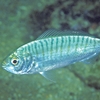General Description
Body long, head small, narrow, slightly flattened, corner of gill cover with two spines, upper longer than lower. Usually greenish to pale brown above, with darker bands and a broken mid-lateral stripe, pale below; some with a spotted or marbled pattern. Tail yellow, covered in dusky spots. To 60 cm.
Biology
The numbers of Rock Flathead are increasing in south-eastern Tasmania. They are most active at night, and their fin spines are venomous.
Habitat
Bays and along the coast, prefers weed-covered rocky reefs or seagrass beds, in depths of 1-20 m.
Reefs
Seagrass meadows
Distribution guide
Southern Australia.
Species Group
Depth
Water Column
Max Size
60 cm
Diet
Carnivore
Harmful
Venomous spines can inflict mild to severe pain.
Commercial Species
Yes
Global Dispersal
Native to Australia
Identify
Conservation Status
- DSE Advisory List : Not listed
- EPBC Act 1999 : Not listed
- IUCN Red List : Not listed






